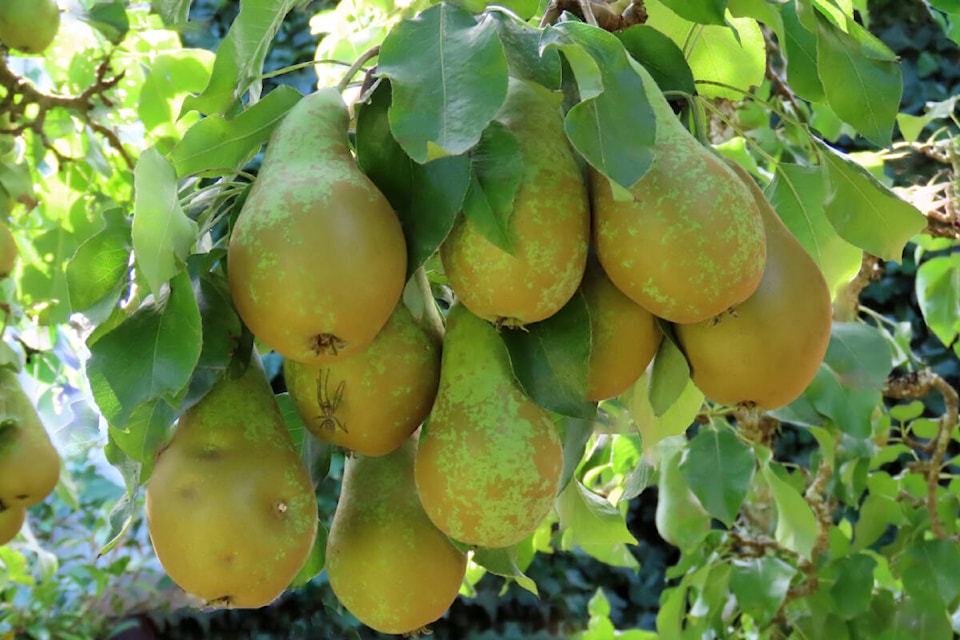By Leslie Cox
Special to the Record
As October progresses towards Halloween, I can almost see the end of the harvest.
The last of the unripe tomatoes from the greenhouse plants are clean and layered between sheets of newspaper in beer flats. Stored in my cool pantry, they will slowly ripen for fresh eating.
Now we are tackling the pears. We have been enjoying them fresh as they have slowly ripened, but it is time to pick up the pace in earnest.
The dehydrator is working on several batches of pear slices, turning them into sweet, tasty treats for easy storage.
The canner is also in production mode, processing batches of pear mincemeat, jams, marmalades and spirited sliced pears that add a punch to Pear Upside Down Cake.
Can you tell we like our pears “dressed” in lots of ways? I confess it is in my blood as my mom truly loved pears. It is thanks to her that I was “made” to help her put up preserves when I was just a kid and decades later, I still enjoy this preserving process.
Working with the pears – peeling and chopping – I and my willing assistant, John, often encounter small hard lumps on the surface of the flesh. Tiny hard pebbles reminiscent of pearls I often found in oysters I shucked with my dad on long ago summer holidays on Hornby.
We know how pearls form, but have you ever wondered how these pear pebbles develop? Well, I have.
Turns out, pear flesh is actually permeated with tiny particles of grit, made up of clusters of brachysclereids (stone cells), a subtype of sclereid cells.
Brachysclereids begin like other cells, with thin primary walls, but that is where the similarity ends. These cells surprisingly begin to box themselves in.
Through windows that connect them to other cells, they import raw ingredients to build a secondary wall…inside of the primary wall.
Building layer upon layer of walls in this manner, the living parts of a brachysclereid cell are squeezed into an increasingly tiny area. Eventually, the window which connected the cell to another cell becomes a tunnel and the entire cell becomes filled with wall. At this point, the brachysclereid cell has achieved its final form and dies.
It is interesting to learn a single brachysclereid cell at this stage can actually be seen with the naked eye. But usually, the hard stone you come across while peeling your pear is a cluster of several dying and dead brachysclereid cells fused together.
So, be careful when you are eating your fresh pears as the stones can be hard on the teeth.
Flaming fruit flies
Now to vent a little…those bloomin’ fruit flies have been driving us nuts!
You’d laugh if you dropped over unannounced because likely we would have answered the door with vacuum in hand and wand extension drawn, looking somewhat like Jedi Warriors. The battle has been ruthless.
And it needs to be. The entire life cycle from a teeny tiny egg to a mature adult, three mm in size, takes only a week.
Add the fact a mature female will lay 500 eggs in her lifetime, given the opportunity, and you can see how the enemy forces can become totally overwhelming very quickly.
Hence, the deployment of the vacuum cleaner. We don’t have the time, or the patience to wait for the vinegar traps to put a dent in the enemy lines. And darned if I am going to sacrifice my scotch in spite of the fruit flies’ preference for my particular brand. Their very numbers were becoming intolerable and unpalatable.
But thanks to the vacuum, the fruit flies have now been almost completely annihilated. I think a wee dram of whisky is called for, don’t you?
Leslie Cox co-owns Growing Concern Cottage Garden in Black Creek. Her website is duchessofdirt.ca



